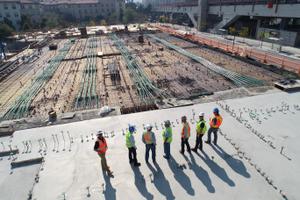Subscribe to our newsletter
Sign up for the latest news & offers from SafeSite
Quick and competitive quotes. Nationwide coverage
Quick quotes. Nationwide coverage
With temperatures soaring above 30C in many places, the construction industry is facing the challenge of keeping workers safe in hot weather.
It may seem logical to work outdoors without a shirt in the heat, but the reality is hot weather poses serious health and safety risks. It is crucial to understand and effectively manage these risks to maintain a safe work environment.
Heat-related illnesses become a significant concern for workers in scorching weather. It is therefore essential for both employers and employees to be aware of these dangers and how to mitigate them. According to the Workplace (Health, Safety and Welfare) Regulations 1992, employers have a duty to ensure that the workplace maintains a ‘reasonable’ temperature.
There is no specific law governing how hot is ‘too hot’ but employers should use their discretion and adapt their practices and policies appropriately.
Under the Management of Health and Safety at Work Regulations 1999, employers are required to conduct a robust risk assessment that includes potential hazards associated with hot weather. This legal obligation means measures must be implemented to protect workers from heat-related risks. Wet bulb globe thermometers can be used to accurately assess working conditions by considering factors such as temperature, humidity, wind speed, sun angle, and cloud cover, all of which contribute to the concept of ‘heat stress.’
Hot weather can cause physiological changes in workers. This can include sweating, changes in blood flow, decreased concentration, and reduced overall performance. All of these can increase the risk of accidents on site. Prolonged exposure to sunlight can lead to severe health conditions such as skin cancer and burns. Other heat-related health issues include heat edema, heat rashes, cramping, heat exhaustion, and in severe cases, heat stroke. Certain construction roles, such as operating heavy machinery or lifting heavy materials, have a higher risk of heat stress. Recognizing these risks and taking preventive action is crucial.

To prevent heat-related illnesses, employers should provide regular breaks in cool, shaded areas. Businesses should also ensure an adequate supply of cool drinking water. You should provide suitable clothing and Personal Protective Equipment (PPE) to protect workers. Employees should also take responsibility for their safety by pacing their work. Remember to regularly use sunscreen, and remove PPE during breaks. Staying hydrated by drinking water regularly is vital to prevent dehydration.
Despite taking precautions, heat-related illnesses can still occur. It is important for employers and fellow workers to be aware of the signs of these illnesses. These can range from mild symptoms like rashes or cramps to severe conditions like heat stroke. Providing first aid and ensuring prompt access to medical attention are crucial responsibilities of employers.
SafeSite Facilities, a company dedicated to site safety and security, strongly advocates for precautionary measures and follows is in our day to day work. We offer a comprehensive range of construction site security products and services.
Soaring temperatures pose serious threats, but with a thorough understanding of the risks, meticulous planning, and diligent use of protective measures, the industry can overcome the challenges of working in high temperatures.
For more information on how SafeSite Facilities can help secure your construction site, click here.
We respond in under 30 mins on average (excl. weekends)